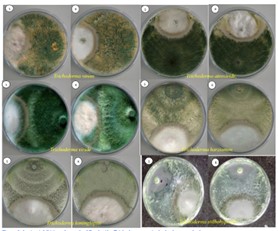
Invitro mycoparasitism activity of Trichoderma spp against Fusarium solani inciting root rot of chickpea ( Cicer arietinum L.)
Abstract
Keywords
Full Text:
PDFReferences
Akbari, L. and A. Parakhia, 2007. Eco-friendly approaches to manage blight of sesame. Journal of mycology and plant pathology, 37(3): 389-400.
Bouziane, Z., L. Dehimat, W. Aziz, M. Benabdelkader and N. K. Chaouche, 2011. The antagonism between Trichoderma viride and other pathogenic fungal strains in Zea mays. Agriculture biology journal of North America, 2(4): 584-590.
Chet, I., G. Harman and R. Baker, 1981. Trichoderma hamatum: Its hyphal interactions with rhizoctonia solani and pythium Akbari, L. and A. Parakhia, 2007. Eco-friendly approaches to manage blight of sesame. Journal of mycology and plant pathology, 37(3): 389-400.
Bouziane, Z., L. Dehimat, W. Aziz, M. Benabdelkader and N. K. Chaouche, 2011. The antagonism between Trichoderma viride and other pathogenic fungal strains in Zea mays. Agriculture biology journal of North America, 2(4): 584-590.
Chet, I., G. Harman and R. Baker, 1981. Trichoderma hamatum: Its hyphal interactions with rhizoctonia solani and pythium
Figure 1: In vitro inhibition of growth of F. solani by Trichoderma spp. in dual culture method.
Figure 2: In vitro inhibition of growth of Fusarium solani by Trichoderma spp. in dual culture method.
spp. Microbial ecology, 7(1): 29-38.
Chiranjeevi, C., I. P. Reddy, M. Naryanamma and Neerja, 2002. Effect of shoot clipping and insecticides on the incidence of fruit borer in brinjal. In: International conferece on vegetables. Bangalore, India.
Cooke, T., 1908. The flora of the presidency of bombay. Bishen Singh Mahendra Pal Singh.
Dubey, S. C., M. Suresh and B. Singh, 2007. Evaluation of Trichoderma species against Fusarium oxysporum f. Sp. Ciceris for integrated management of chickpea wilt. Biological control, 40(1): 118-127.
El-Mougy, N. S., N. G. El-Gamal and M. M. Abdel-Kader, 2007. Control of wilt and root rot incidence in Phaseolus vulgaris L. By some plant volatile compounds. Journal of plant protection research, 47(3): 255-265.
Gupta, V. and A. Misra, 2009. Efficacy of bioagents against fusarium wilt of guava. Journal of mycology plant pathology, 39(1): 101.
Harman, G. E., 2006. Overview of mechanisms and uses of Trichoderma spp. Phytopathology, 96(2): 190-194.
Harman, G. E. and C. P. Kubicek, 2002. Trichoderma and Gliocladium: Basic biology, taxonomy and genetics. CRC Press.
Johnson, L., 1957. Effect of antibiotics on the numbers of bacteria and fungi isolated from soil by the dilution-plate method. Amer Phytopathological Soc 3340 Pilot Knob Road, St Paul, Mn 55121, Phytopathology: pp: 630-631.
Jolicoeur, P., 2012. Introduction to biometry. Springer Science & Business Media.
Kumar, P., A. Misra and B. Pandey, 2007. In vitro evaluation of trichoderma spp. Against vegetative mango malformation pathogen Fusarium moniliforme var. Subg/utinans. Journal of ecofriendly agriculture, 2: 187-189.
Morton, D. and N. Stroube, 1955. Antagonistic and stimulatory effects of microorganism upon Sclerotium rolfsii. Phytopathology, 45(8): 419-420.
Nene, Y., M. Sexena and K. Singh, 1984. A review of ascochyta blight of chickpea. Martinus Nijhoff/Dr. W. Junk Publishers. The Haque, Netherland, 1(1): 17-36.
Rajkonda, J., V. Sawant, M. Ambuse and U. Bhale, 2011. Inimical potential of Trichoderma species against pathogenic fungi. Plant sciences feed, 1(1): 10-13.
Ramos, B., F. M. Alves-Santos, M. A. García-Sánchez, N. Martín-Rodrigues, A. P. Eslava and J. M. Díaz-Mínguez, 2007. The gene coding for a new transcription factor (ftf1) of Fusarium oxysporum is only expressed during infection of common bean. Fungal genetics biology, 44(9): 864-876.
Sahi, I. Y. and A. Khalid, 2007. In vit o biological control of Fusarium oxysporum-r causing wilt in Capsicum annuum. Mycopathology, 5(2): 85-88.
Simmons, E., 2007. Alternaria. An identification manual. Utrecht.
Tewari, A. and A. Mukhopadhyay, 2001. Testing of different formulations of Gliocladium virens against chickpea wilt-complex. Indian phytopathology, 54(1): 67-71.
Vincent, J., 1947. Distortion of fungal hyphae in the presence of certain inhibitors. Nature, 159(4051): 850-850.
Waghmare, S. and B. Kurundkar, 2011. Efficacy of local isolates of Trichoderma spp. Against Fusarium oxysporum F. Sp. Carthami causing wilt of safflower. Advances in plant sciences, 24(1): 37-38.
DOI: https://doi.org/10.33865/wjb.006.03.0430
Refbacks
- There are currently no refbacks.
Copyright (c) 2021 Andoji Yogesh S, Sutar Aruna S

This work is licensed under a Creative Commons Attribution 4.0 International License.
Print ISSN: 2522-6746 : Online ISSN: 2522-67541. How to register 2. How to reset password2. How to prepare a manuscript before submission 3. How to submit a paper 4. How to check the review status of a paper5. How to check the plagirisim or similarity report